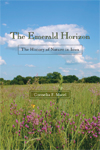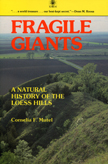The Emerald Horizon
"Nature for many today is the drainage creek down the block or the wooded ravine leading away from the highway. The Emerald Horizon rolls back the clock to a time when Iowa was a checkerboard of wetlands that turned seamlessly to oceans of native grasses; when fire, wind, and rivers determined whether prairies or woodlands rose from the rich soil. Mutel shows Iowa as a dynamic, almost breathing life form, altered nearly beyond recognition in just a few decades. This book offers hope for restoring the land but the key will come from those who read this book and take it to heart."—Joe Wilkinson, president, Iowa Wildlife Federation
"The Emerald Horizon conveys a vivid, accurate, and thoughtfully constructed story of Iowa's natural history. Not only has Mutel translated a complex history of natural and anthropogenic factors into an explanation of Iowa's former and current landscapes, she also presents a call for restorative action. The loss of so much of Iowa's natural heritage is heartbreaking, but The Emerald Horizon provides the reason and encouragement we need to protect and restore what we have left."—Thomas Rosburg, Drake University
"Mutel has written a poetic history of our compromised land—and she has a vision for returning diversity and community to the Iowa landscape."—Teresa Opheim, executive director, Practical Farmers of Iowa
In The Emerald Horizon, Cornelia Mutel combines lyrical writing with meticulous scientific research to portray the environmental past, present, and future of Iowa. In doing so, she ties all of Iowa's natural features into one comprehensive whole.
Since so much of the tallgrass state has been transformed into an agricultural landscape, Mutel focuses on understanding today's natural environment by understanding yesterday's changes. After summarizing the geological, archaeological, and ecological features that shaped Iowa's modern landscape, she recreates the once-wild native communities that existed prior to Euroamerican settlement. Next she examines the dramatic changes that overtook native plant and animal communities as Iowa's prairies, woodlands, and wetlands were transformed. Finally she presents realistic techniques for restoring native species and ecological processes as well as a broad variety of ways in which Iowans can reconnect with the natural world. Throughout, in addition to the many illustrations commissioned for this book, she offers careful scientific exposition, a strong sense of respect for the land, and encouragement to protect the future by learning from the past.
The "emerald prairie" that "gleamed and shone to the horizon's edge," as botanist Thomas Macbride described it in 1895, has vanished. Cornelia Mutel's passionate dedication to restoring this damaged landscape—and by extension the transformed landscape of the entire Corn Belt—invigorates her blend of natural history and human history. Believing that citizens who are knowledgeable about native species, communities, and ecological processes will better care for them, she gives us hope—and sound suggestions—for the future.
Preface
Acknowledgments
Prologue
1. Setting the Stage
2. A Miracle of Sight, Scent, and Sound
3. The Great Transformation
4. Prairies Today
5. Oak Woodlands and Bottomland Forests Today
6. Restoring Nature's Systems
7. Present Quandaries, Future Quests
Epilogue
Appendix. Common and Scientific Names of Native and Naturalized Plants in the Text
Bibliographic Acknowledgments
References Cited
Index





